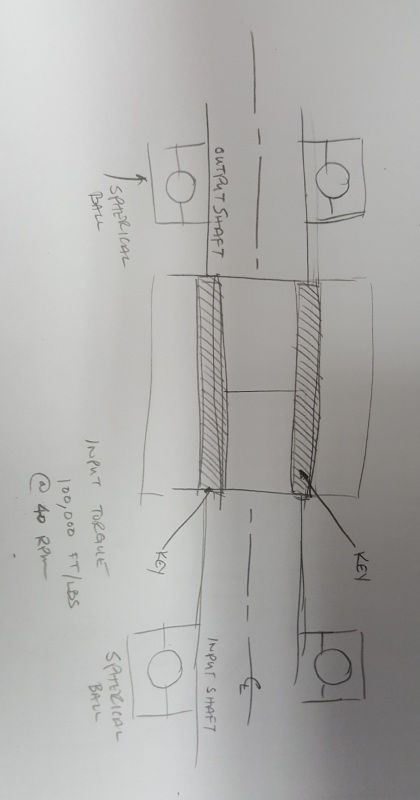Macht
Mechanical
- Jun 21, 2017
- 4
Good afternoon,
I am working on a rigid coupling that connects a gearbox to a driven shaft.
The shaft being coupled is a 10.125" Dia shaft (4140 @ 200-240 Brinell )seeing a 100,000 ft lbs of torque.
The shaft is keyed using a pair of 3.5 x 2.5" rectangular keys made from key steel @ 180 degrees apart.
The Rigid coupling halves (Ductile Iron) house a key each, and are approximately 22" in Diameter, and use (8) 2" Grade 8 bolts.
If I am understanding the power transfer correctly the two keys are carrying the torque transmitted by the shaft, while the rigid coupling bolts and the clamping force is just resisting the resultant separating force created by the keys.
Under that assumption the coupling is significantly over designed, but i am having trouble going through the calculations.
Any assistance would be greatly appreciated.
Macht
I am working on a rigid coupling that connects a gearbox to a driven shaft.
The shaft being coupled is a 10.125" Dia shaft (4140 @ 200-240 Brinell )seeing a 100,000 ft lbs of torque.
The shaft is keyed using a pair of 3.5 x 2.5" rectangular keys made from key steel @ 180 degrees apart.
The Rigid coupling halves (Ductile Iron) house a key each, and are approximately 22" in Diameter, and use (8) 2" Grade 8 bolts.
If I am understanding the power transfer correctly the two keys are carrying the torque transmitted by the shaft, while the rigid coupling bolts and the clamping force is just resisting the resultant separating force created by the keys.
Under that assumption the coupling is significantly over designed, but i am having trouble going through the calculations.
Any assistance would be greatly appreciated.
Macht

